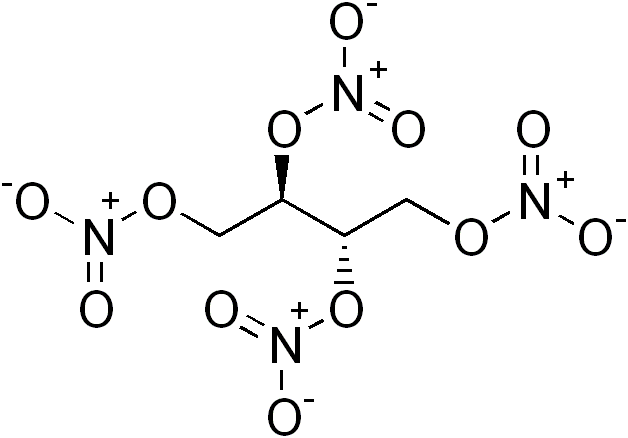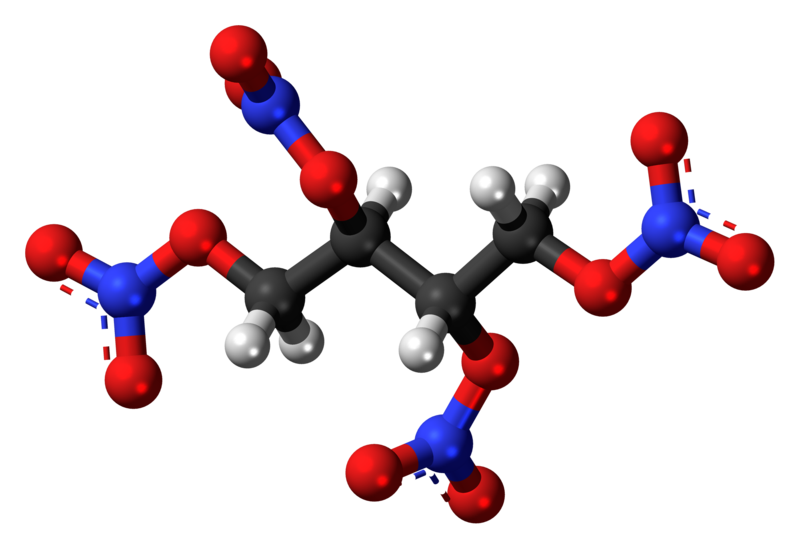Eritrityl tetranitrate

| |

| |
| Names | |
|---|---|
| IUPAC name
[(2R,3R)-1,3,4-Trinitrooxybutan-2-yl] nitrate
| |
| Identifiers | |
3D model (JSmol)
|
|
| ChEBI | |
| ChemSpider | |
| ECHA InfoCard | Lua error in Module:Wikidata at line 879: attempt to index field 'wikibase' (a nil value). Lua error in Module:Wikidata at line 879: attempt to index field 'wikibase' (a nil value). |
PubChem CID
|
|
| UNII | |
| |
| |
| Properties | |
| C4H6N4O12 | |
| Molar mass | 302.11 g/mol |
Except where otherwise noted, data are given for materials in their standard state (at 25 °C [77 °F], 100 kPa). | |
| Infobox references | |
Editor-In-Chief: C. Michael Gibson, M.S., M.D. [1]
Overview
Erythritol tetranitrate (ETN) is an explosive compound chemically similar to PETN.[1] It is however thought to be 1/3 more sensitive to friction and impact. ETN is not well known, but in recent years has been used by amateur experimenters to replace PETN in improvised detonation cord or in boosters to initiate larger, less sensitive explosive charges. Due to the availability of erythritol as a natural sweetener and its relative ease of production in relation to PETN, ETN is a favoured homemade explosive compound to the amateur experimenter.
Like many nitric esters, ETN acts as a vasodilator, and was the active ingredient in the original "sustained release" tablets, made under a process patent in the early 50s, called "nitroglyn". Ingesting ETN or prolonged skin contact can lead to absorption and what is known as a "nitro headache".
Properties
ETN has a relatively high velocity of detonation of 8000–8100 m/s at a density of 1.6 g/cm3. It is white in color and odorless. ETN is commonly cast into mixtures with other high explosives. It is somewhat sensitive to shock and friction, so care should be taken while handling. ETN dissolves readily in acetone and other ketone solvents.
Much like PETN, ETN is known for having a very long shelf life. Studies that directly observed the crystalline structure saw no signs of decomposition after four years of storage at room temperature.
Oxygen balance
One quality this explosive has, that PETN does not, is a positive oxygen balance. Having a positive oxygen balance means that ETN possesses more than enough oxygen in its structure to fully oxidize all of its carbon and hydrogen upon detonation. This can be seen in the equation below.
- 2 C4H6N4O12 → 8 CO2 + 6 H2O + 4 N2 + 1 O2
Whereas PETN decomposes to:
- 2 C5H8N4O12 → 6 CO2 + 8 H2O + 4 N2 + 4 CO
The carbon monoxide (CO) still requires oxygen to complete oxidation to carbon dioxide (CO2).
Thus for every mole of ETN that decomposes, 1/2 free mole of O2 is released. This could be used to oxidize an added metal dust or an oxygen deficient explosive such as TNT or PETN.
Manufacture
Like other nitrated polyols, ETN is made by nitrating erythritol through the mixing of concentrated sulfuric acid and a nitrate salt. Ammonium nitrate is commonly used for this type of reaction. The erythritol is added to the mixture to begin its nitration. Much better yields can be obtained by using concentrated nitric acid in place of the nitrate salt, in which case the sulfuric acid is used simply to absorb water and act as a catalyst from the resulting esterification, driving the reaction.
See also
References
- ↑ Erythritol tetranitrate was first synthesized by British chemist John Stenhouse (1809-1880) in 1849. He extracted the simple sugar erythritol (which he called "erythroglucin") from lichen and then studied its chemistry. See: John Stenhouse (1 January 1849) "Examination of the proximate principles of some of the lichens. Part II," Philosophical Transactions of the Royal Society (London), vol. 139, pages 393-401. Reprinted in German as: John von Stenhouse (1849) "Über die näheren Bestandtheile einige Flechten," Justus Liebigs Annalen der Chemie und Pharmacie, vol. 70, no. 2, pages 218-228. Condensed version (in German): John Stenhouse (12 Sept. 1849) "Über die näheren Bestandtheile einige Flechten," Pharmaceutisches Centralblatt, vol. 20, no. 40, pages 625-628.